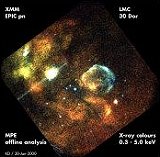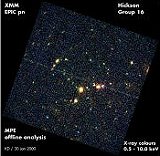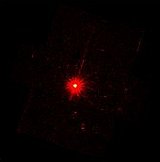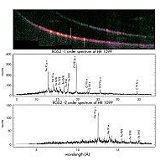| First light images from XMM-Newton |
Text obtained from ESA press release
The first pictures from ESA's new X-ray space
observatory fully demonstrate the capabilities of the spacecraft's
telescopes and its science instruments. The images were officially
presented on 9 February 2000 at the XMM-Newton Science
Operations Centre in Villafranca, Spain.
The images were obtained between 19-25 January 2000 at the very start of the
science payload commissioning process. The spacecraft viewed three regions
of the sky: part of the Large Magellanic Cloud (LMC), the Hickson Cluster
Group 16 (HCG-16), and the star HR 1099. These targets were chosen because
they all present a variety of X-ray extended and point sources and are very
interesting regions.
The expanding cauldon in the Large Magellanic Cloud
The Large Magellanic Cloud also known as the Nebula Major is about 20
thousand light years in diameter. Situated 160 thousand light years from
Earth, it is one of two irregularly shaped galaxies that are easily seen
with the naked eye in the southern hemisphere. These galaxies are satellites
of the Milky Way and appear to be slowly spiralling into our own Galaxy.
 EPIC-PN false colour X-ray image of the 30 Doradus
region in the large magellanic clouds
EPIC-PN false colour X-ray image of the 30 Doradus
region in the large magellanic clouds
This X-ray colour image made with the EPIC camera on XMM shows
part of a small companion galaxy to the Milky Way, the Large
Magellanic Cloud, where stellar explosions are releasing newly
manufactured elements, and new stars are being formed. The image
is made so as to reveal the temperature of the X-ray emitting
medium, with blue indicating the hottest regions; green the
intermediate temperatures and red the coldest regions. Most of
the 'blue' X-rays have not been observed before, and it is the
collecting power of XMM that enables these observations.
|
The first image obtained by the EPIC-PN X-ray cameras viewed the 30 Doradus
region of the Large Magellanic Cloud. Also called the Tarantula Nebula, 30
Doradus is a cauldron of creation where exploding stars are releasing vast
amounts of matter and where new stars are being born. The image presents
the million degree temperatures of the emitting medium, with blue indicating
the hottest regions; green intermediate temperatures and red the coldest
regions. The white and blue arc-like formation just off the centre is a
new object, only part of which was known in the past. It has the appearance
of a supernova remnant with its expanding glowing-hot gas producing X-ray
emission as it collides with the interstellar medium.
On the lower right of the picture is the remains of a star that exploded as
Supernova 1987A on 24 February 1987. It was the first supernova to reach
naked-eye brightness since 1604 (Kepler's star) and remained visible to
the naked eye for nearly nine months. The brightest source in the view,
upper left, is another supernova remnant (N157D).
Martin Turner, Principal Investigator for the EPIC cameras: "These first
pictures are tremendously exciting after so many years of work. They are all
that we hoped they would be. In the LMC we can see the elements, which go
to make up new stars and planets, being released in giant stellar explosions.
We can even see the creation of new stars going on, using elements scattered
through space by previous stellar explosions. This is what we built the
EPIC cameras for and they are really fulfilling their promise."
Multiwavelength views of Hickson Group 16
The HCG-16 viewed by EPIC and by the Optical Monitor in the visible and
ultraviolet wavelengths is one of approximately a hundred compact galaxy
clusters listed by Canadian astronomer Paul Hickson in the 1980s. The
criteria for the Hickson cluster groups included their compactness, their
isolation from other galaxies and a limited magnitude range between their
members. Most Hicksons are very faint, but a few can be observed with
modest aperture telescopes.
 EPIC-PN false colour X-ray image of a group of galaxies
known as HCG 16
EPIC-PN false colour X-ray image of a group of galaxies
known as HCG 16
XMM brings to bear the largest X-ray telescopes in space, and
this is shown here. These colliding galaxies are 170 million
light years away, and are clearly visible to EPIC. In the
background more than a hundred faint X-ray sources are seen,
most of these are new detections by XMM.
|
Galaxies in Hickson groups have a high probability of interacting. Their
study has shed light on the question of galactic evolution and the effects
of interaction. Investigation into their gravitational behaviour has also
significantly contributed to our understanding of 'dark matter', the
mysterious matter that most astronomers feel comprises well over 90% of our
universe.
 Composite image of OM-V filter (left) and UVW1 filter (right)
Composite image of OM-V filter (left) and UVW1 filter (right)
The optical image of the Hickson galaxy group taken with XMM's
Optical Monitor instrument is compared with an ultraviolet image
taken with the same telescope. Routine access to ultraviolet
images of the sky is another first for XMM, allowing us to pick
out the hottest sources in the sky, which are most likely to be
responsible for the X-ray emission.
|
Observation of celestial objects from space over a range of X-ray,
ultraviolet and visible wavelengths, is a unique feature of the XMM-Newton
mission. The EPIC-PN view of the Hickson 16 group shows a handful of
bright X-sources and in the background more than a hundred faint X-ray
sources that XMM-Newton is revealing for the first time.
Juxtaposing the X-ray view of HCG 16 with that of the Optical Monitor
reveals one of the great strengths of XMM-Newton in being able to routinely
compare the optical, ultraviolet and X-ray properties of objects.
Many of the X-ray sources are revealed as elongated 'fuzzy blobs' coincident
with some of the optical galaxies. Routine access to ultraviolet images is a
first for the mission, allowing astronomers to learn much more about
individual objects. Obtaining a ratio of the brightness of individual
sources seen with different filters ('filter spectroscopy') gives
indications on their temperature and composition. Using XMM-Newton to
search for variability from sources such as these will enable astronomers
to hunt for those elusive black holes thought to lurk at the centres of many
galaxies.
 Composite image of EPIC-PN false colour X-ray (left)
and OM-V filter (right)
Composite image of EPIC-PN false colour X-ray (left)
and OM-V filter (right)
X-ray image of the Hickson galaxy group taken with the XMM X-ray
telescopes compared to the optical image of the galaxies taken
simultaneously with XMM's Optical Monitor telescope. The ability
to record images simultaneously over a range of wavelengths is
an important first for XMM, allowing new X-ray discoveries to be
placed immediately in the context of more familiar images from
the optical portion of the spectrum.
|
"The performance of our instrument is very much as we expected" says
Keith Mason, Principal Investigator for the Optical Monitor. "We have
worked for over a decade on this mission and it is very exciting having the
first data. And the pictures really show all the value of the multi-wavelength
approach of the XMM design."
HR1099 in an infernal waltz
HR 1099 is a sixth magnitude star located about a 100 light years from the
Sun only just visible to the naked eye. Its formidable brightness in the
EPIC-MOS image conceals in fact a binary pair. Whereas our Sun rotates in 30
days, these two stars are whizzing around each other in only 3 days.
 PIC-MOS X-ray image of the field around star HR1099
PIC-MOS X-ray image of the field around star HR1099
X-ray image of the field around the bright star HR1099. This
X-ray image also illustrates the collecting power of XMM, as
many of the other X-ray sources in the image were hitherto
unknown, or allow more detailed studies of these objects than
before. HR1099 is a nearby star with a hot corona which is very
active in X-rays.
|
The rapid motion causes a kind of infernal dynamo, twisting the stars'
magnetic fields into contorted shapes. If one star resembles our own Sun,
its partner is infinitely more active than our Sun. It is the scene of
intense stellar flares and storms which astronomers believe are due to the
release of magnetic energy as the fields untwist. Measuring the phenomena
that are present greatly helps us understand the way our own Sun functions
and its effects upon us. Again this X-ray image reveals many serendipitous
sources, hitherto unknown.
Discovering the elements
The final two examples of the initial data collected by XMM-Newton take the
form of spectra. They are provided by one of the two Reflection Grating
Spectrometers (RGS). Just as in optical spectroscopy, different elements
absorb and emit light at specific and unique points of the radiation
spectrum. The RGS spread these out in the form of two "bananas", the two
so-called 'spectral orders' of the instrument. Emission lines appear as
distinct features in the rainbow of X-ray colours, acting as signatures
that reveal a great deal of information to astronomers.
 RGS spectrum of HR1099
RGS spectrum of HR1099
RGS spectrum of the star known as HR1099. The spectrum
illustrates the way the RGS works; it decomposes X-ray 'light'
into its components, like a prism does with visible light. The
inserted image shows what is referred to as a 'banana' image.
The horizontal axis shows the detected X-ray photons (X-ray
light particles) plotted as a function of the position on the
detector (strip of nine CCDs) and as a function of the energy of
the photons, as determined by the CCDs, along the vertical axis.
|
The RGS spectra of HR 1099 are examples. The graphs display peaks or lines
that correspond to the various elements present in the source. One can
distinguish for instance the presence of different types of iron, oxygen
carbon and neon. From the analysis of this data one can deduce the
temperatures, densities, abundances and velocities of the different
materials.
 RGS spectrum of HR1099
RGS spectrum of HR1099
The RGS spectrum of the star known as HR1099. This illustrates
the wealth of detail offered by analysis of data obtained by the
RGS instrument. The top panel shows the detected X-ray photons
(X-ray light particles) plotted as a function of the position on
the detector (strip of nine CCDs) along the horizontal axis and
as a function of the energy of the photons, as determined by the
CCDs along the vertical axis.Two bands can be seen, the bottom
one which is the brightest is the so-called first spectral
order, the top one is the second spectral order. The middle
panel is a plot which shows the intensity or the number of
detected photons along the vertical axis - versus their
wavelength, a measure of their energy, along the horizontal
axis.
|
"Firstly, the nice separation of the two spectral order bands shows the
resolution of the RGS CCDs is well up to expectations" comments Bert
Brinkman, RGS Principal Investigator. "For the spectrometers as a
whole, the resolution which is of prime importance, is exactly or
marginally better than what we expected after the ground calibrations. The
instruments promise a lot for the future."
All the images reveal hitherto unknown X-ray sources. Faint point sources
barely perceptible with previous X-ray space telescopes appear in all their
splendour. Understanding everything they show is somewhat premature since
the XMM-Newton instruments have yet to be calibrated.
XMM Project Scientist Fred Jansen says: "As these are the very first
astronomical data and we are already observing lots of new science,
XMM-Newton holds a very clear promise for an exciting and scientific
future." ESA's Director of Science Prof. Roger Bonnet is equally
impressed. "I am amazed by the quality of the pictures as compared to
previous X-ray missions. We see on them a lot of new sources, especially in
the parts of the spectrum which correspond to the hottest temperatures and
we see that the Universe is hotter than we thought and that many new sources
are appearing. We are very hopeful that many more objects will be discovered
and that by extending the temperature measurements of the Universe to many
objects, we will have a much better picture of the history and the hectic
behaviour of stars at the end of their life".
The Calibration and Performance Verification phase for XMM-Newton's science
instruments is to begin on 3 March 2000, with routine science operations
starting in June 2000.
 EPIC-PN false colour X-ray image of the 30 Doradus
region in the large magellanic clouds
EPIC-PN false colour X-ray image of the 30 Doradus
region in the large magellanic clouds




